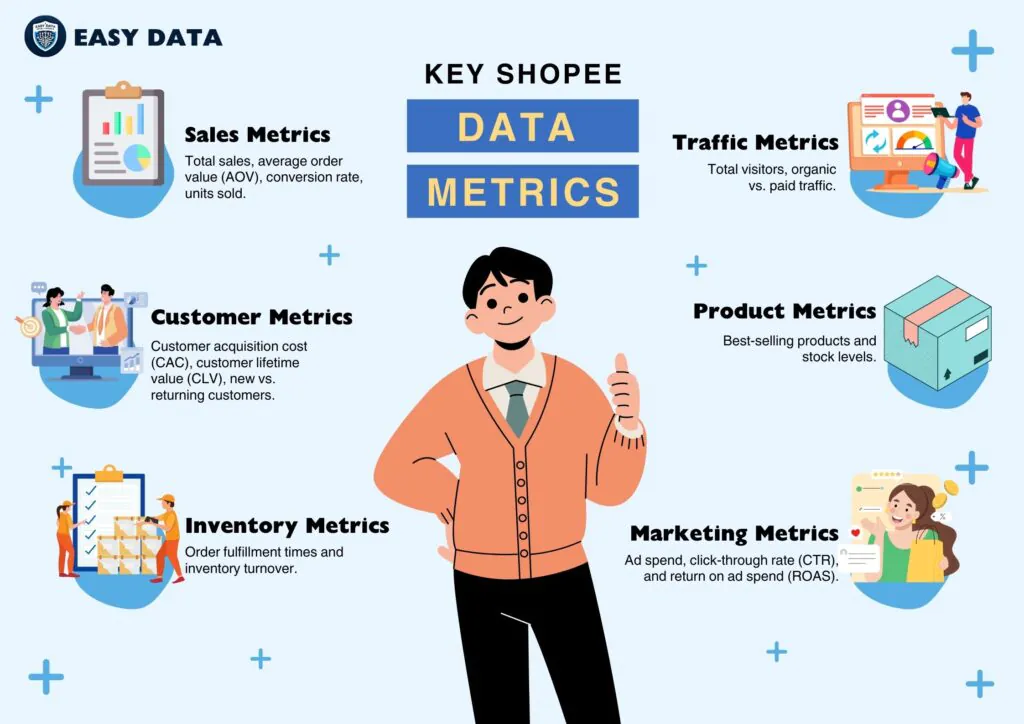In today’s highly competitive e-commerce landscape, leveraging data analytics is crucial for success. Shopee, one of the leading online shopping platforms in Southeast Asia and Taiwan, is no exception. For sellers, marketers, and businesses, analyzing Shopee data is an effective way to make informed decisions, boost sales, and refine marketing strategies. This guide will cover the tools and techniques for analyzing Shopee data, providing you with actionable insights to grow your business.
- 1. Why Analyzing Shopee Data is Important?
- 2. Key Metrics to Analyze in Shopee Data
- 3. Data Sources in Shopee
- 4. Essential Tools for Analyzing Shopee Data
- 5. Techniques for Analyzing Shopee Data
- 6. Common Challenges in Shopee Data Analysis
- 7. How to Use Shopee Data to Improve Business Performance
- 8. Conclusion
1. Why Analyzing Shopee Data is Important?
Shopee’s ecosystem is dynamic, with millions of daily transactions and numerous vendors competing for consumer attention. By analyzing Shopee data, businesses can unlock opportunities to enhance performance, optimize marketing spend, and improve customer experience.
Some key benefits of Shopee data analysis include:
- Improved Decision-Making: Data-driven insights enable more accurate and timely decisions in areas such as inventory management, pricing, and promotional strategies.
- Better Customer Understanding: Analyzing data on customer behavior, preferences, and purchase patterns can help businesses tailor their products and services accordingly.
- Competitive Advantage: Detailed insights into competitor performance, market trends, and price fluctuations provide an edge over rivals.
- Revenue Growth: Optimizing product listings, promotions, and pricing based on data analysis can significantly increase sales.
2. Key Metrics to Analyze in Shopee Data
To extract actionable insights, focusing on the right metrics is crucial. Some of the key metrics for Shopee sellers include:

a. Sales Metrics
- Total Sales: Revenue generated from product sales.
- Average Order Value (AOV): The average amount spent by customers per transaction.
- Conversion Rate: The percentage of visitors who make a purchase.
- Units Sold: The total number of units sold during a specific period.
b. Traffic Metrics
- Total Traffic: The number of visitors to your product listings or Shopee store.
- Organic vs Paid Traffic: Understanding the proportion of free (organic) traffic and traffic driven by paid ads.
c. Customer Metrics
- Customer Acquisition Cost (CAC): The cost associated with acquiring a new customer.
- Customer Lifetime Value (CLV): The predicted revenue a customer will generate during their lifetime relationship with your store.
- Returning vs New Customers: The ratio of new customers to those returning to make additional purchases.
d. Product and Inventory Metrics
- Top-Selling Products: Identifying your most popular items.
- Stock Levels: Monitoring inventory to prevent stockouts or overstocking.
- Order Fulfillment Time: Time taken to fulfill and ship orders.
e. Marketing Metrics
- Ad Spend: Tracking spending on Shopee Ads and other marketing channels.
- Click-Through Rate (CTR): The percentage of people who clicked on your ad out of those who saw it.
- Return on Ad Spend (ROAS): Revenue generated per dollar spent on ads.
3. Data Sources in Shopee
Before diving into data analysis, it’s essential to understand the sources of Shopee data. Some of the primary sources include:
a. Shopee Seller Center
Shopee’s Seller Center provides valuable insights into store performance, including sales, traffic, and customer behavior reports. Sellers can access real-time data, allowing them to monitor their store’s health and track performance over time.
b. Shopee Ads Dashboard
For sellers using Shopee’s advertising tools, the Shopee Ads Dashboard provides detailed insights into ad performance. Metrics such as impressions, clicks, CTR, and ROAS can be extracted from this dashboard to optimize ad campaigns.
c. Third-Party Analytics Platforms
Several third-party platforms integrate with Shopee, offering deeper insights and reporting capabilities beyond the native tools available in Shopee Seller Center.
d. Social Media and Google Analytics
If you are running off-platform marketing campaigns (e.g., on Facebook or Google), linking Shopee with Google Analytics or tracking tools on social media will give you a more comprehensive view of your traffic and conversion sources.
4. Essential Tools for Analyzing Shopee Data
To successfully analyze Shopee data, you need the right tools. Some are built into Shopee itself, while others are third-party solutions designed to enhance analytics capabilities.

a. Shopee Analytics Tools
- Shopee Seller Center: Offers built-in analytics for tracking sales, traffic, and customer activity. You can also export reports in CSV format for further analysis.
- Shopee Ads Dashboard: Provides insights into your advertising campaigns and their effectiveness, enabling you to optimize your ad spend.
b. Google Analytics
By integrating Shopee with Google Analytics, you can track on-platform and off-platform traffic. Google Analytics provides comprehensive reporting on user behavior, acquisition channels, and conversion funnels. With this integration, you can see which sources are driving traffic to your Shopee store and optimize marketing efforts accordingly.
c. Data Visualization Tools (Tableau, Power BI)
Visualization tools like Tableau or Power BI allow you to transform complex data into easy-to-read charts and graphs. By integrating Shopee data into these tools, you can visualize performance metrics, identify trends, and communicate insights more effectively.
d. Custom Analytical Solutions (Python, R)
For more advanced users, Python or R can be used to conduct sophisticated analyses on Shopee data. These programming languages offer powerful libraries like Pandas, NumPy, and ggplot for analyzing large datasets and generating predictive models.
5. Techniques for Analyzing Shopee Data
There are several analytical techniques that can be used to extract valuable insights from Shopee data.
a. Sales Performance Analysis
Regularly analyzing sales data helps identify trends and potential growth opportunities. Key considerations include:
- Tracking sales performance by product, category, or time period.
- Analyzing customer purchase behavior to understand which products are most in demand.
- Using sales data to forecast inventory requirements and avoid stockouts.
b. Customer Behavior Analysis
Understanding how customers interact with your Shopee store can provide insights into improving user experience and increasing conversions. Some techniques include:
- Funnel Analysis: Tracking the user journey from landing on your store to completing a purchase.
- Cohort Analysis: Grouping customers based on common characteristics (e.g., first-time buyers) to analyze retention and engagement patterns.
c. Pricing Analysis
Monitoring competitor pricing and assessing customer sensitivity to price changes are key to optimizing pricing strategies. Use Shopee data to:
- Identify the optimal price point for each product.
- Track competitors’ pricing and promotions.
- Analyze how price adjustments affect conversion rates and sales volume.
d. Competitor Analysis
Keeping an eye on the competition is essential for staying ahead in the e-commerce space. Shopee data can help you monitor:
- Competitors’ best-selling products.
- Price fluctuations and promotional strategies.
- Customer reviews of competing products to identify potential gaps or areas for improvement in your offerings.
6. Common Challenges in Shopee Data Analysis
Despite the benefits of analyzing Shopee data, businesses often face some common challenges:
- Data Overload: Shopee provides a wealth of data, and extracting meaningful insights from this data can be overwhelming without the right tools or expertise.
- Data Accuracy: Inconsistent or inaccurate data can lead to poor decision-making. Ensuring data accuracy is key to effective analysis.
- Integrating Multiple Data Sources: Combining data from Shopee with other platforms like social media, email, and external advertising channels can be challenging.
- Real-Time Analytics: Many businesses struggle to make decisions in real-time, as data analysis may take time, causing delays in implementing changes.
7. How to Use Shopee Data to Improve Business Performance
Once you’ve collected and analyzed your Shopee data, the next step is to apply your findings to improve performance:
- Optimize Product Listings: Use data on customer behavior and product performance to optimize product descriptions, images, and categories.
- Personalized Marketing: Use customer segmentation and behavior analysis to create personalized marketing campaigns tailored to different customer groups.
- Inventory Management: Analyze sales trends and forecasts to adjust stock levels and avoid stockouts or overstocking.
- Price Optimization: Continuously monitor market and competitor pricing to adjust your pricing strategies and remain competitive.
- Improve Customer Service: Use data on customer reviews and feedback to identify areas where you can enhance customer satisfaction.
8. Conclusion
Analyzing Shopee data can provide businesses with critical insights into sales performance, customer behavior, and competitor activities. By leveraging the right tools and techniques, you can make informed decisions that drive growth and enhance customer experiences. Whether you’re using Shopee’s native analytics, third-party tools like Google Analytics, or custom analytical solutions like Python and R, data analysis is a powerful tool to unlock the full potential of your e-commerce business on Shopee.
With consistent data analysis, you can stay ahead of the competition, optimize your business operations, and, ultimately, achieve sustained success in the fast-paced world of online retail.
Ready to take your Shopee data analysis to the next level?
Visit easydata.io.vn to learn more about how our advanced analytics solutions can help you grow your e-commerce business. Book a demo today to see how we can turn your data into actionable insights!

Leave a Reply